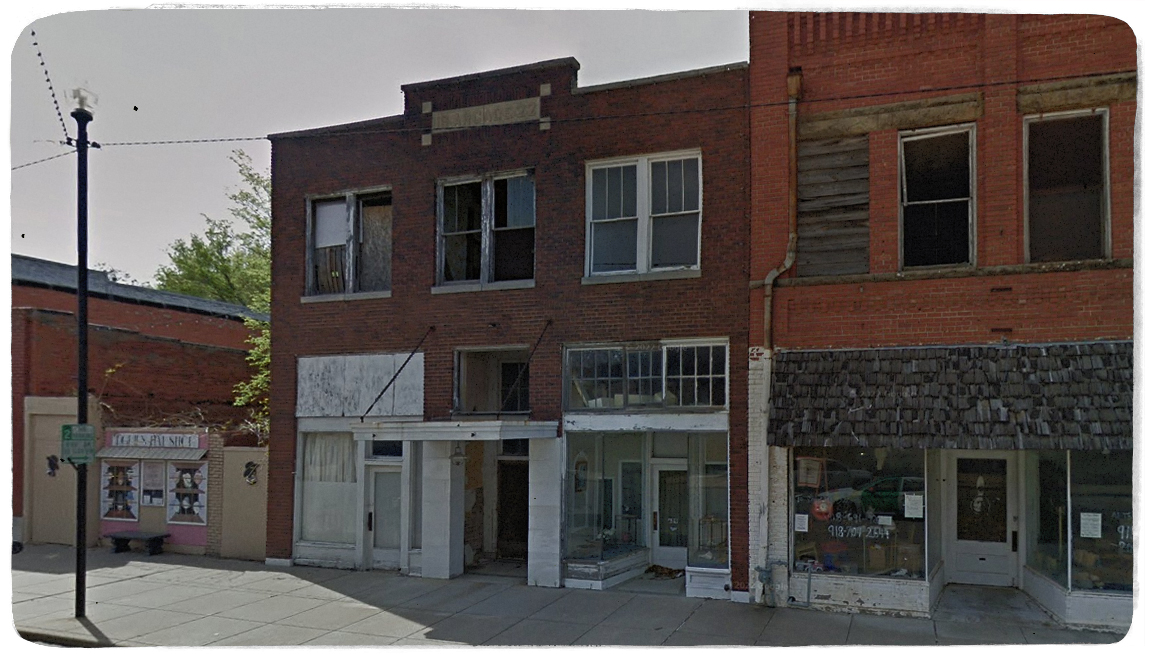
The Arcade Building at 629 Kiheka Avenue where James Youngdeer's film office was located in Pawhuska, Oklahoma. The top header image is from James Youngdeer's 1910, White Fawn's Devotion.
Return to Table of Contents for films
Going through news articles concerning the Osage, I came across one on Chief Baconrind appearing in a 1925 movie that was filmed in Osage County, Oklahoma, The Unknown Man. Its leading actor was a William Fitch, married to Rosa Logan, Osage daughter of John Logan and Mary Corndropper. She had a part in the film as well. My attention was partly drawn to this because Baconrind's daughter, Julia, had as a first husband (married 1922) Andrew Brave, and I was aware his sibling, Louis, had been a consultant on the movie Cimarron in 1931. Louis had moved, in 1928, to Hollywood, with his wife Marie Tessie "Hummingbird" Mobley, who was a mixed-Chickasaw opera singer and actress. She used her Indian name as her stage name, Lou-Scha-enya, appearing in Eddie Cantor's Whoopee in 1930.
Los Angeles Evening Express, 19 June 1930
Chief Bacon Rind, 80 years-old Osage Indian, and 50 of bis tribesmen will soon be on their way to Hollywood to appear In Radio Pictures' 'Cimarron.' The Indians were signed by Doran Cox, assistant director, representing RKO. who returned from Oklahoma, where he has been filming prairie scenes for the forthcoming production. Cox Cox and Louis Brave, a full-blooded Oeagc, made a thorough search of libraries and family albums In the locale of the Edna Ferber story, seeking authentic data on costumes, types, and practices of the early Indian Territory days. Chief Bacon Rind will play the part of Big Elk In the Richard Dlx starring vehicle.
Tessie's sister, Marie, married a Muchmore, resided in Dallas, and captured famed footage of President Jack Kennedy's assassination. Thought I'd drop that in there.
But to get back to the movies. I knew about Cimarron. What was The Unknown Man? This seemed worth exploring, a movie made in 1925 that purportedly used talent from Osage County, Oklahoma and gave the general citizenry ample opportunity to appear in crowd scenes. I was surprised to find no information on it at IMDB.
Below is a collective drop of news articles on not only The Unknown Man, but another movie that was staged in Osage County, Oklahoma subsequently, and then yet another that was soon thereafter done on The Osage Reign of Terror. The director was an individual born James Young Johnson, who later went by the name of James Young Deer, then James Gordon Youngdeer, famed as the "first documented film director of Native American ancestry". By at least 1910 he was giving himself as full Winnebago and went to Carlisle Indian School (see the below news item from 1910 July 7). But when people poked at his story after his death they found lots of holes. Historians determined to find out who he was. To make a long and complex story short, what he was hiding was that his family was mixed Indian and African-American, his father's paternal side descending from the Nanticoke, eventually recognized by the state as a "special class" of people in 1881, only 31 individuals at first, including one of James' great-uncles, then recognized by the state in 1922 as an official tribe. His father's maternal line descended from a family listed in "Free African Americans of Maryland and Delaware from the Colonial Period to 1810". Always, in documents, his various family lines were listed as Black or Mulatto until 1880 when James Young Johnson was four years of age and they were given as white. James' father died in 1878, his mother in 1890, and he was in the service by 1898. I don't find him on the census in 1900, but in 1906 James married Lillian St. Cyr, a Winnebago whose stage name was Red Wing, and would soon become a star. He was James Younger Johnson, and they both gave themselves as Black, though Lillian St. Cyr was Winnebago.
James transitioned to being only Native American, dissociating himself from his past life, and from then on used the name James Young Deer (Youngdeer), his wife using it as well.
It was a complex situation. Historians wonder if James ever knew he was descended from Nanticoke Indians as his father died when he was a child, but I'm going to assume that he did. If you examine the Nanticoke families, as it often is with such groups, they were tight, the families married into one another. I find his grandfather, Major Clark Johnson, lived until 1891, his aunt Frances "Fanny" Johnson Booth lived until 1901, and his great-uncle Whittington Johnson lived until 1896. The three Johnsons who were members of the Nanticoke association, as well as the three Clarks were family, the Clarks through his great-grandmother Mary Clark, who had married Robert Johnson, and were parents of Whittington Johnson and Major Clarke Johnson. Virtually everyone on the initial list of 31 individuals would be relations in some way. But being recognized as descended from the Nanticoke wasn't going to cut it. Just as when James began filming Indian-themed movies in the east, the public was dissatisfied with eastern shrubbery and trees, wanting their Indians to be from across the Mississippi. James Young Johnson dealt with that complex Nanticoke and African-American heritage by fabricating a full Winnebago indian history, transferring his birth from Washington D.C. to Dakota City, Nebraska, and acquiring a father named "Green Rainbow". This would open doors of opportunity to him, as he set out to make Indian-themed movies, that probably wouldn't have been available to him as a mixed-blood Nanticoke, a people not recognized until 1881 and often viewed as mulatto. James' mother, Emma Young, was mulatto, not Nanticoke. His grandmother on his father's side, Lydia Ann LeCount, was mulatto, not Nanttcoke. Though there was considerable racism against Native Americans, it wasn't the same type of racism experienced by African Americans.
Lillian St. Cyr, first appearing in a film called "The White Squaw" in 1908, is sometimes mistakenly credited as the first indigenous film actress--and does it really matter who is first or second. She would be in many films by a number of different directors, including D. W. Griffith, but the 2nd film she was in was directed by her husband, James Young Deer, who made a career out of filming Indian-themed westerns that often featured his wife. The majority of these films were produced 1911 to 1914, the years for which he was head of production for Pathe Freres West Coast Studio, but the films he did in 1914 were in the U.K., to where he'd moved. Not by his own volition. He'd gotten into trouble, which I won't get into here, but having just escaped landing in prison for statutory rape and other allegations, he went to the U.K. to reinvent himself as a director of thrillers.

James Y. Johnson "Youngdeer" with wife Lillian St. Cyr, from Fred J. Balshofer's 1910 film "Young Deer's Return."
Then there's a disruption of activity, he and Lillian had already separated or were separated during this time, and in 1920 two more films are directed by him in the U.K. and then one in 1924. After having directed 32 films between 1909 and 1915, then 2 films in 1920, his IMDB career ends with the U.K. film, "The Lieutenant Darin RN and the Water Rats", released in 1924.
The book Starring Red Wing! The Incredible Career of Lilian M. St. Cyr, the First Native American Film Star by
Linda M. Waggoner, does a great job of covering the early years of the marriage of Lillian St. Cyr and James, and one should refer to it for information on Lillian's life and those early years with James.
For more on the uncovering of James' identity see Angela Aleiss' "Who Was the Real James Young Deer? The Mysterious Identity of the Pathè Producer Finally Comes to Light".
My concern is with the years 1920 to 1926, filling in a gap of knowledge with James concerning his Oklahoma years. And that's where the news items I've gathered come in.
Before those years in Oklahoma, I need to begin with the movie, Watuska, as I believe we first see with this his association with a woman I will later be able to identify as Lillian Beatrice King.
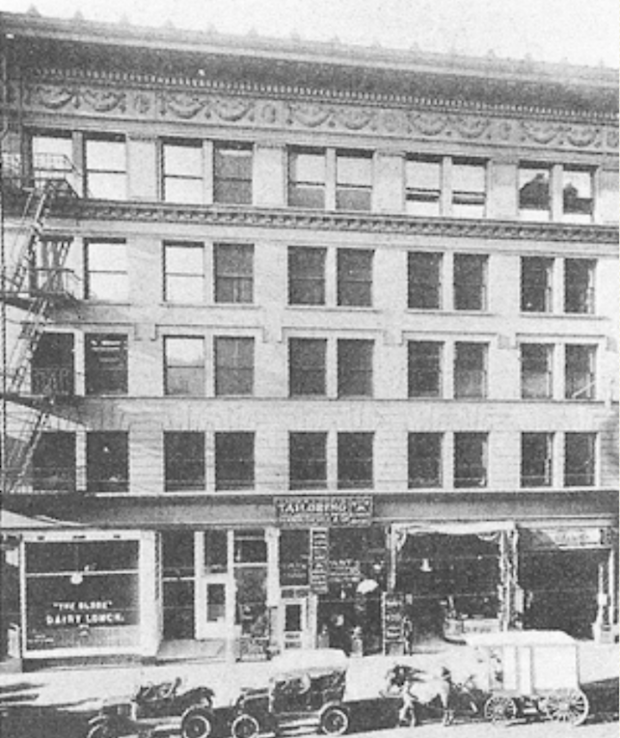
The Henne building in LA, where the office was for Youngdeer Productions/Film Corporation
Photo circa 1915, from Sons of the Revolution in the State of California web site
If you refer to the below articles, you'll see that on 5 March 5 1920 James Youngdeer announced the formation of Youngdeer Productions, a Los Angeles film company, and that it would be filming a movie called Watuska about "a real Indian princess." On
March 19, an article revealed that Watuska was the granddaughter of "one of the most notable chiefs that ever ruled over the Creek Indian nation." Though in the header she is given as "Princess Watuska", the body of the articles off somewhat from the description of her as a "princess", clarifying that, "The princess is a complimentary reminder of the old royal line." Who was this new American Indian actress that James was promoting? He doesn't say. On the 27th a Raymond Jareski was signed to play the half-breed "Wolf"
The "Camera" publication stated Cecil de Freitas was currently photographing the Watuska, a seven reel feature. Production started on 4 April, but by April 12 there are already problems. An article appears in which Youngdeer's studio is suggested to be opportunistically extracting money from individuals with promises of possible work. On May 13th le loses a suit filed against him for not having paid two assistant directors for nine weeks of work, individuals he had simply dropped.
One of those individuals who was sued as part of Youngdeer Film Corporation was an Anemone Page. James Y Deer on 18 April 1920 in Los Angeles, California is recorded as having married Anomine Page. That's a wife I don't think has been recorded and I've no clue who she is.
One of the assistant directors who filed suit and won was a John T. Loomis, who I find on the 1920 census as an actor employed by Mercury, as was also his wife, Dorothy.
By June 5, James was running from the law, sought by officers for selling stock certificates in a film producing venture without a permit. According to the officers, he and an "Indian woman known as 'Red Wing' were last said to have been headed toward a government reservation in Oklahoma."
The Stranger, advertised as Strangers played in Brooklyn. And in Antwerp, France, Royal Zoologie having formed the respected Royal-Zoologie theater, when forced to shut down its animal exhibits, from the 25th of February through the 2nd of March, Cine Zoologie featured by the Royal-Zoologie in Antwerp on a double bill with The Cabinet of Dr. Caligari.
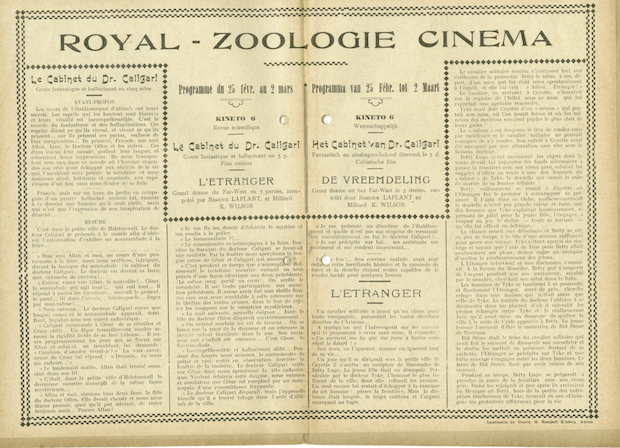
The Strangers at Cine Zoologie

Youngdeer Film Company Presents "The Stranger"

Jame Y Deer marriage to Anomine Page
That marriage to "Anemone Paige" kind of threw me for a loop as I'd already found another unknown marriage for James and thought I had things worked out concerning his running off to Oklahoma with, supposedly, Red Wing. Was it Red Wing, Lillian Youngdeer? Or was it someone else? Perhaps another Lillian Youngdeer?
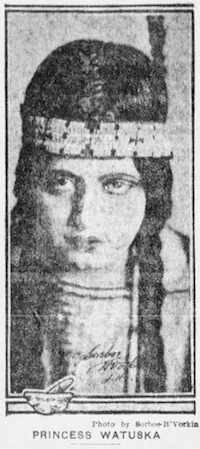
Princess Watuska
In 1924, a movie was released in the U.K. for which James Young Deer shared director credit with Edward Gordon and Percy Moran, Lieutenant Daring RN and the Water Rats. One of the women featured in it was Leila King as Lola. IMDB had no information on her, and I thought it a little too coincidental that James Youngdeer would then show up in Oklahoma in 1924 with a woman named Lillian A. King, and that she would star in The Unknown Man and does other work on the film, such as continuity. She then stars in the 1925 What a Woman Can Do and the 1926 Tragedies of the Osage Hills. Might Leila King be Lillian A. King?
I started researching her and found an Oklahoma Indian Land Allotment Sale document for a woman given as half Creek Indian, Lillian Beatrice King "now Young Deer". Then I found an article in which James Youngdeer identified Lillian King as having starred in Lieutenant Daring RN and the Water Rats. So it was the same woman.
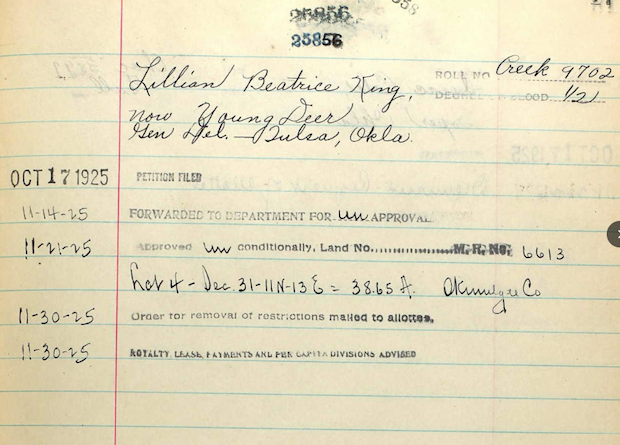
Lillian Beatrice King as Lillian Beatrice Youngdeer
And what about Princess Watuska, the Creek Indian whose grandfather was an important Creek chief? Lillian Beatrice King (1900 - 1956), born in Henryette, Okmulgee, Oklahoma, was the great-granddaughter of Chief William Chillicouthe "Chilly" McIntosh, who Wikipedia gives as "an important figure in the history of the Creek Nation. Born in Georgia to William McIntosh, chief of the Lower Creeks and his wife Eliza, he was the half-brother of D. N. McIntosh, and the nephew of Roley McIntosh, another Creek Chief." Chilly was important because, with his father, he signed a treaty which sold Creek-claimed land in Georgia, an act that was against a Creek law, presuming to act for the entire Creek Nation. This was punishable by death, and Chief William McIntosh was killed and his house burned. Chilly escaped, taking refuge with the Cherokee, then in 1828 led the Lower Creeks, who would be known as the McIntosh faction, to their new home in the west.
It appears she was first married to Ray Whitetree, a Senaca Indian, by 1918, and military records reveal they are no longer married by 1919. In the January of 1920 census she is divorced and living with her family in Okmulgee, Oklahoma, working as a bookkeeper in a lawyer's office.
Did she meet up with Youngdeer in Oklahoma or California? Jesse P. Wills had been one of the officers of Youngdeer Productions in Los Angeles, and one has to wonder how he came to be in California when he was working as a mail carrier in Verdigris, Rogers, Oklahoma in 1920. Why he was working as a mail carrier when he was a lawyer, I don't know. But how did he, too, make his way to Los Angeles in 1920, at the same time as Lillian King? How did they both meet James Youngdeer?
When I first learned James had married Lillian King (well, as best as he could marry anyone else as he and Lillian St. Cyr never officially divorced), I believed they probably married around 1920 and, as another Lillian Youngdeer,she would have been the one headed with James to a reservation in Oklahoma, and not Red Wing.
But what about Anemone Paige (Anomine Page)? I couldn't find anything at all on Anomine Page other than her father was William. Though William Paige was given on the marriage license, I was inclined to wonder if this could be Lillian Beatrice King, whose father was named William. The certificate was in error with James giving his father as James, rather than George (I could swear I've seen this error in another document though I don't right now recall where, I have gone through a lot of documents concerning them), but his mother is correctly given as Emma. I have seen many other cases where parents would be not listed appropriately, it's not that uncommon, but I wondered if there was intentional obfuscation, such as with James becoming "James Y Deer". It's a name that's much the same as James Youngdeer but it could slip through the cracks as well and mean not being able to track a person's history.
Lillian, I knew, had married subsequently to an Earl Pearson, but I had been unable to find them in the census before 1950. Then I finally located them in the 1940 census, in Galveston, Texas. Earl's wife was given as Anemone Pearson, which confirms Lillian Beatrice King, aka Lillian A. King, as Anemone Page.
Earle Rathke Pearson married Mrs. Lillian King Wright in Harris, Texas on 18, Jan, 1935. I don't know who Mr. Wright was.
Osage, Oklahoma newspapers were abuzz with Youngdeer's appearing in Osage, Oklahoma in November of 1924 to film "The Unknown Man" under the company name of Arrowhead Motion Pictures. It was to be full feature length film, whereas James Young Deer had made his name with shorts--but no one wanted shorts anymore, they wanted features. The plot concerned "a beautiful girl [and] the attempts of the villain and his confederates to beat her out of the valuable oil lease". This was topical, considering the Osage Reign of Terror that was then being investigated, Osage Indians murdered for their headrights. Though some timelines for the Osage Reign of Terror don't show William King Hale becoming a suspect until September of 1925, and they wouldn't be arrested until January 1926, the FBI was already aware of William King Hale and his Burkhart nephews by at least April of 1924.I
A description of the film's story appears to give the wronged woman in the story as white, but at least in a news article of 22 October, 1924, in the Pawhuska Daily Journal, the film's star was stated to be of "Indian blood"--and she was, indeed, mixed-Creek, though this isn't stated.
Pawhuska Daily Journal, 22 October 1924
Lillian A. King Versatile Woman
Has Played Lead Parts and is Scenarist and Continuity Writer of Ability
Miss Lillian A. King, with the Arrow Head Film Company of this city, is an Oklahoma product, hailing from Henryetta. She is of Indian blood and has had a varied career on the screen where she has played lead parts in a number of large productions. She is a woman of fine personality and of ability and of a type of beauty that has enabled her to play a most varied number of screen parts. She has appeared in numerous screen dramas in England and in this country but for the past few years has specialized in scenario work and continuity writing in which she has grown most proficient.
Among screen successes in which Miss King appeared in England are "Belle of the Gambling Den," put out by the Master Company, "Repentance" by the B and Z company; "The Man Behind the Scene" by the British and Colonial; "Dad's Boy" by the Mutual, and many others. In Berlin, she was leading lady in a screen success, "She and the Wax Figures" staged by the Decla Bioscope. While in Spain, Miss King appeared in an attractive role in a play staged there among surroundings that were suitable to the theme. She has appeared in several successes of the screen in this country. Of a brunette type, she is capable of playing parts of great variation from the dark haired Spanish and Indian characters to the lighter haired Saxon types popular in this country.
The Arrow Head company has fitted out offices in the Arcade building where operations will be started looking toward the production of a comedy-drama with a local setting and local people within a short time. J. Gordon Youngdeer, manager of the company and who will direct the action, has word from two of the largest companies of the cast indicating that they will be in the market for anything that he will produce in this locality in the way of western plays. He expects to produce about six of the sort between now and the end of the year. He is now casting parts with local people to be used in the first western to be staged.
Assuming she and Youngdeer were already married, there's no indication of this in the article. I'm unable to locate any news or materials on the other films Lillian was stated to have been in other than the 1921 Belle of the Gambling Den, filmed in the U.K., in which she isn't credited on IMDB. You'll notice that her appearance in James' 1924 Lieutenant Daring RN and the Water Rats isn't mentioned, as if she is being distanced from having previously worked with Youngdeer, who is given in this article as J. Gordon Youngdeer.
The 22 October article is written in a way to show that everyone in Pawhuska was already well-acquainted with the coming filming of The Unknown Man. Guy Marple, who write the story for The Unknown Man, was city editor for The Capital in Pawhuska, later becoming a district court official. The Capital was startet in Jan 30 1904 and the Journal on Dec 10 1904, and combined in 1925 to form the only daily newspaper in Osage County, The Pawhuska Journal-Capital.
Youngdeer had begun advertising for talent in the Pawhuska Daily Journal on the 21st.
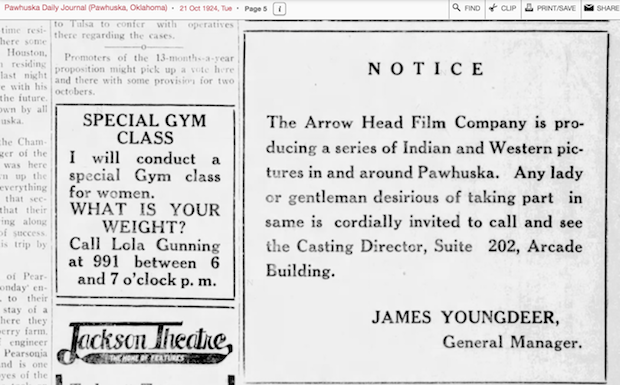
Was this another pay-to-play scheme? And then, if one is guaranteed a role in a film, however small, should we consider a pay-to-play scheme on that order to be a con and that the film is somehow not legitimate? I'm not going to say that Youngdeer hadn't run cons, and we know he had failed to pay workers and had taken money for roles that didn't materialize. But what about if people are willing to pay to be in a film? If a director goes to a town and presents them an opportunity, at their cost, to be in a film that showcases their area? Is that exploitation? Does it immediately invalidate the film?
But Youngdeer, at least in the papers, was out to give the impression that he wanted to build a studio in Oklahoma, preferably in Pawhuska, that would place the midwest on the map as a film center, so that movie-making didn't just belong, in America, to Los Angeles and New York.
Whatever gave Youngdeer the idea to locate in Pawhuska, he already knew people there. Lillian having been officially introduced to the public on the 24th, on the 26th of October an article appeared in which it was stated that Youngdeer was surprised to meet up with, in Pawhuska, J. P. Willis, a lawyer who had previously worked with him, president of Youngdeer Productions in Los Angeles. J. P. was stated to be probably relocating in Pawhuska.
J.P. had been an officer with Youngdeer Productions on the Watuska film, which was shot, but apparently never finished, Youngdeer appearing to have abandoned filming prior to the news of his leaving because of having run afoul of the law in connection with its production. Jesse Palmer Willis, born in Iowa in 1892, had relocated with his parental family to Rogers, Oklahoma before 1910. By 1922, he had married, in Kay County, Oklahoma, Minnie LeSarge, who hailed from a well-known mixed-Osage family. Her parents were Louis Napoleon LeSarge and Mary Josephine Pappan. Louis LeSarge's parents had been Jean Baptiste LeSarge and Francoise Roy, of Osage and Kaw descent. On the Roy side, Minnie was related to the Revelettes, the Lesserts, the Roys who had been on the Nemaha Mixed-Breed Reservation, and so many other names that had gone on to marry full blood Indians and mixed-blood, and whites. On the Pappan side she had as her great-great grandfather the Kaw chief White Plume, who married a daughter of the Osage Chief Pawhuska (White Hair). She was on the Osage Roll, #1134. Though Willis and Youngdeer are no longer presented as associates, Willis would become involved in a business venture with Franklin Fitch, an area man who was the featured male lead in The Unknown Man. Jesse Willis' father, a hotel proprietor in Claymore, had owned a good deal of real estate there, and Willis fell in line. He and Fitch purchased the entire interest of a ranch/quarter horse farm in Claymore by July of 1925. Willis also purchased the Miller building in Pawhuska, which had been a major sports entertainment venue.
We can put together some partial credits for The Unknown Man based on news articles:
Franklin Fitch as Kit Karzan
G. G. Germain (Grover German) playing Sure-Fire Gale, a crooked lawyer (replaced by Fred Haskett from Hollywood)
Lillian A. King as Alice Winters, daughter of a southern gentleman
Mrs. Frances Yarlotte playing Mrs. Winters (replaced by Mrs. Bauer)
Walt Naylor playing Pitt McGrew, a bandit
Rosie Fitch playing indian wife of Pitt McGrew
Buck Starr as assistant chief of the bandit gang;
Walter Mosier as Zev, the colored servant of Karzan (replaced by Lewis Carter)
Kate, a girl of the mountains, played by Mary M. Moser
"Pappoose Nina" as an Indian baby
Miss Lorraine Ivers playing Katie Cline
Gene "Chief" Baird playing Chief Wakoma
Chief Baconrind as Chief Wakomah's father
Bill Bryant as sheriff
Vera Poulton as a deputy sheriff
Poul Poulton as Cowboy Pete (replaced by Walter Mosier)
Colonel W. G. Bass as Skedes Walters, auctioneer
Cowboys, bandits and other characters played by Lillian Austin, Ben and John Burnett, Walter Cook, Charlie Clark, Alva Carter, W. C. Coy, Joseph Delois, Dan Frey, Scott Green, John Swinn, Luellan and Gailend German, Choc Hampton, George Hadley, Stella King, Shelby McGraw, Ira Marshall (cook); Herman Roach, Otto Tollet, Jay Snively, Soapy Williams.
Story author, Guy Marple
General Manager, Grover G. German
Operator of still camera, E. E. Call of Tulsa
Operator of moving camera: Henry J. Maire
Scenario continuity by Lillian A. King.
Franklin Fitch's wife was Rosa Logan, Osage, daughter of John A. Logan and Mary Corndropper.
Lorraine Ivers would have been the wife of Hayes Little Bear, Osage.
Walter Mosier would have been the son of Eugene Mosier, Osage, and Frances McGraw. Grover German was married to Mary Mosier, a daughter of Eugene Mosier and half-sister of Walter.
Poul Poulton was likely the son of Edward Poulton and Martha Fitzgerald, Martha having married Foster Strikeaxe, Osage, after her first husband's death in 1917. Poul was married to Vera Cottingham whose mother was Ida Ross, Osage. Alva Carter was likely the son of George Carter and Minnie Kennedy, who was mixed-Osage, Shelby McGraw may be the son of Alice Grass McIntosh, Cherokee, previously married to Chief James Bigheart. Herman Roach may have been the son of Samuel Roach, his grandmother being Ursula Revard, a mixed-Osage family. Ben and John Burnett were likely the sons of Antoine Burnett and Adella Matney. Ben was married to Emmy Strikeaxe, daughter of Foster Strikeaxe. Frank Haskett had a Hollywood connection through his brother-in-law, John Tiber, living in LA, being a cabinetmaker for Hollywood studios (from Tiber's his obituary). Walt Naylor was a well-known cowboy and, rodeo contestant. Bill Bryant would have been the deputy sheriff of Pawhuska.Buck Starr was a deputy sheriff in Hominy.
Filmed entirely in Osage County, on the Mosier Ranch, in Avant and Pawhuska, The Unknown Man premiered in Pawhuska, on the 27th and 28th of February 1925, at the Jackson Theater, to hundreds of individuals and the news states they applauded it as a good film--beautifully photographed, as well-acted as most films, and with some nice thrilling touches.
From the Cinema Treasures website, the State Theater. at 201 W. Main Street in Pawhuska. was formerly the Jackson Theater, Having opened in the 1910s, it was renovated in 1928, at which point it became the State Theater. The theater held 432 people. Later publicity for Youngdeer would state The Unknown Man was seen by 3000 people at the Jackson.
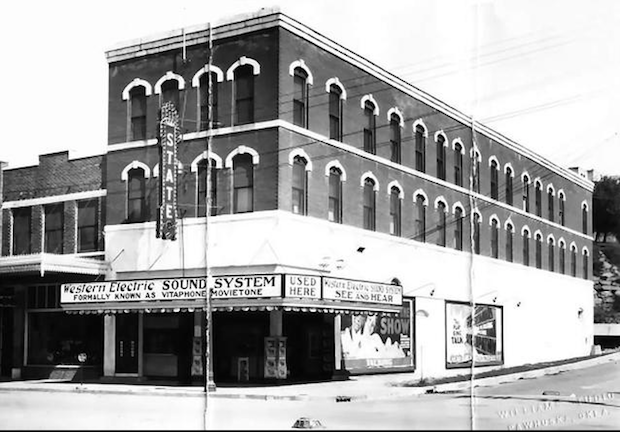
The Jackson Theater where the movie was screened
Photo from Cinema Treasures website
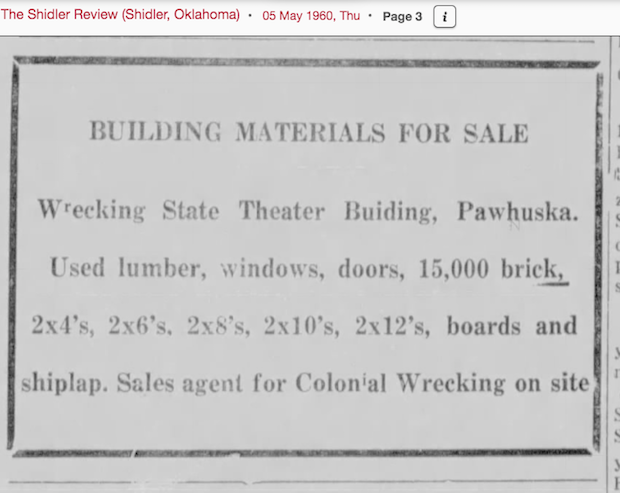
The Jackson Theater was demolished in 1960
By January of 1925, before the premiere of The Unknown Man the news was being published that a local film studio was to be incorporated, with James Youngdeer hoping it would be in Pawhuska, and on March 12th it was published that a motion picture company had been formed, a venture that "should commend itself to people interested in seeing Pawhuska remain a progressive city". Officers were G. C. Schoenover, Barton Carter and Bill Bryant. Alva Carter, Buck Starr and Fred Whittaker were interested backers.
G. C. Schoenover may have been Grover C. Schoonover. Grover's mother was Cherokee, Annie Mary Muskrat. He was married to Lola Perrier whose father, Louis Napoleon Parrier, was mixed-Osage, and her mother, Ellen Haynie, mixed-Cherokee. Barton Carter was likely the brother of Alva Carter, who had acted in The Unknown Man, sons of George Carter and Minnie Kennedy, who was mixed-Osage, Fred Whittaker was perhaps a barber from Fairfax.
The filming of a second feature, The Stranger in/from the Hills, was being planned in December of 1924 and begun about March 1924. Whatever the original story was supposed to be, in March it was announced the name had been changed to What a Woman Can Do, to fit a plot concerning young women from the east coming west and learning to be cowgirls, but there were also gypsies somehow involved in the plot. Many locals were again included, but it featured Hollywood talent Helen Holmes, "Queen of the railroad serials", who from 1913 to 1926 was in 141 films. Her career was at its end, though she did 12 films in 1925.
What credits I can put together are:
Hellen Holmes
Lillian A. King
Stella King (who was a younger sister of Lillian's)
A.R. Ranch owner - Val Vino
Sheriff - Bill Bryant
Bootlegger villain - Walt Naylor
Ranch Foreman (who resigns) - Lloyd Saunders
Officer - Frank Haste
Continuity by - Lillian A. King
Story by Guy Marple
After some delays, the movie. produced by the Red Arrow Film Company, was apparently supposed to premiere June 11-13, Thursday, Friday and Saturday (or did they mean June 18-20), but I find nothing else on it. The next news item I locate, after the June 11th announcement of the premiere, is a July 28th item out of Bartlesville about the Arrowhead Film Company interviewing talent there for a new film, already in production, an office to be opened there with Shirley Shreeves in charge, who was stagemanager for the "Cutler-Jack" interest.
Did this film premiere that weekend? What happened? Again, it's not listed on IMDB.

The Thompson Hotel in Cushing, Oklahoma where Thompson Moving Picture Corporation located.
Something had gone sour, because a studio didn't materialize in Pawhuska or Bartlesville. Instead, one opened in Cushing, Youngdeer having teamed up with local hotel owner Frank L. Thompson, the purpose of this venture seeming to have been solely for the filming of Tragedies of the Osage Hills, which purported to tell the true story of the Osage Reign of Terror, William King Hale and the Burkharts having been arrested in January of 1926. Preliminary hearings had been held in March. It wasn't until June that the trials would begin.
Also given as a Thompson Film Company production, the only credits I've been able to dig up are:
Miss Lillian A. King as Prairie Flower
Jack Rich
Walt Naylor as a federal officer
Patsy Mitchell
Kate Spencher as a bootlegger
Gene Slaton as a "member of the notorious gang"
Bob Selfridge
Jean Pack
Charles King as Chief of the Outlaws
Little Bernice Williams
Slim Williams
Eddie McClellan
Lela Walker
Sadie Davis
Eddie Ellis
George Somebody [sic]
It premiered on May 11th, 1926 in Cushing.

Announcement of the premiere of Tragedies of the Osage Hills

Ad for Tragedies of the Osage Hills
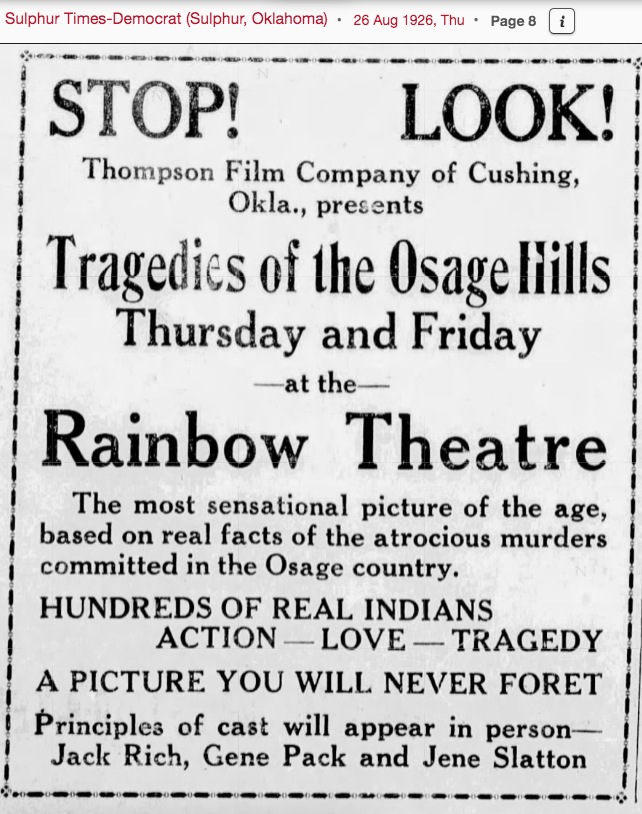
Ad for Tragedies of the Osage Hills
Was this film already being planned in 1925, and was perhaps a reason why the title Stranger in the Hills was changed to What a Woman Can Do? The film's production ended on a sour note with Youngdeer suing Thompson, in September of 1926, who he said had taken possession of the reels. Frank Thompson died not long thereafter on 5 January 1927.
In 1929, Reymond RedCorn published Arthur Henry Lamb's Tragedies of the Osage Hills: As Told by the 'Sage' of the Osage, which had stories on the Osage Reign of Terror, but included many more items besides. Did Lamb draw his title from the Youngdeer-Thompson movie, or had Youngdeer and Thompson gotten wind of this as a title for a prospective book?
The research of others shows that the Great Depression found him living in a boarding house in the Mission District in San Francisco, reinvented as an Indian born in Oklahoma, now a theater instructor. On July 17 1930 he married, in Douglas, Cochise, Arizona, a Scottish immigrant, Helen Gilchrist, who died 6 June 1937 in Los Angeles. The informant was James who gave them as having lived in California 7 years, and that she'd been in the US 12 years. She was buried in an unmarked grave.
I've seen it questioned if this was because the marriage was illegitimate, he and Lillian "Red Wing" having never divorced--and I have found that on James' death certificate his wife is listed as L. Margaret, which would be Lillian Margaret St. Cyr. But I've seen a lot of "illegitimate" marriages in my time doing genealogy, and I've never seen any one of them buried in unmarked graves because of it. I would instead believe it had only to do with financial constraints.
Lillian Margaret was not only listed as James' wife on his death certificate, she was also the informant.
Name: James Y Johnson
Gender: Male
Race: White
Marital Status: Married
Age: 68
Birth Date: 1 Apr 1878
Birth Place: Wash, D C
Residence Street Address: 250 W 67 St
Residence Place: New York
Death Date: 6 Apr 1946
Hospital: Bellevue Hospital
Death Place: New York City, Manhattan, New York, USA
Cause of Death: Carcinoma of The Stomach, Cachexia
Burial Date: 10 Apr 1946
Burial Place: Long Island National Cemetery
Occupation: Retired Gov'T Pension
Father's Birth Place: Pennsylvania
Mother's Birth Place: Wash, D C
Father: George G Johnson
Mothe:: Emma Johnson
Spouse: L Margret
Informant: M L Johnson
Informant Gender: Female
Informant Relationship: Wife
Executor: Margaret L Johnson
Executor Relationship: Wife
Certificate Number: 8457
In their later years, James and Lillian "Red Wing" lived near each other in New York. Threads still connected them, and, after all, they were still married, but "she had nothing good to say about him".
It's an interesting story. It'd make a fascinating bio film, these several years working on films in Pawhuska and Cushing, if they could keep the story under control and not twist it into something completely unrecognizable. There had been so much tragedy in Osage county, and they were in the midst of the investigations into the osage oil murders--imagine also the somewhat diverting excitement of a film being produced there, and a film company perhaps even establishing itself in the area.
What happened to The Unknown Man? FIve (probably) reels of movie all filmed in Osage County, with reservation people, and Chief Bacon Rind. And it's so gone that it's not even remembered on IMDB, though it was completed and premiered in Pawhuska.
One wonders happened to What a Woman Can Do , if it was premiered, or if there's no further mention of it because it was never completed.
And Tragedies of the Osage Hills, which, however fictional, may have been the first treatment of the Osage murders? The likelihood is that it was trash exploitation. But what if it wasn't? We'll likely never know.
Do any of these films exist or are they long since land-fill? Did Youngdeer really have a dream of making Pawhuska into a film center, or was it a con from the beginning, or was he the kind of person where it was going to have to ultimately crash and burn? No matter intentions, one hundred years later, wouldn't it be amazing to have these films that were made in the area, featuring people from the area? It's not going to happen, but I wonder what other materials might be out there on the making of these films?
* * * * * *
Personal note. My paternal family was, for several generations, in Chautauqua County, Kansas, and Osage County and Kay County, Oklahoma, having moved to the area in the 1870s, and were on the Osage Reservation before Oklahoma became a state. Family members married Osage and Ioway tribal members, and neighbors were consistently Osage tribal members and descendants of individuals allotted on the Nemaha "Mixed-Breed" Reserve in Nebraska, so many of these names are already familiar to me through my genealogical research that broadly extends into historical community context as well.
September 2022. Approx 7893 words or 15 single-spaced pages.
Return to the top of the page.